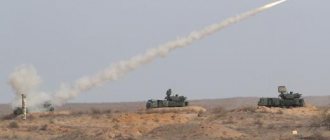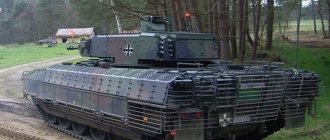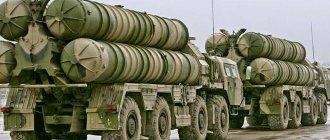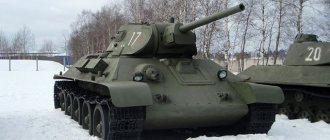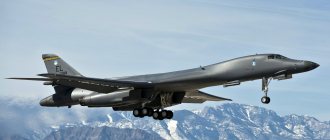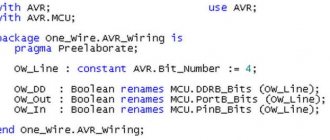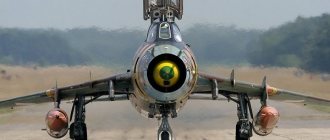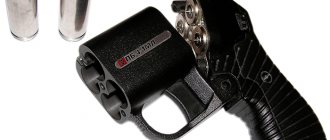S-300PMU2 "Favorit", anti-aircraft missile system
The universal mobile multi-channel anti-aircraft missile system S-300PMU-2 “Favorite” is designed for the defense of the most important objects of the state and its armed forces from massive attacks by modern and advanced aircraft, strategic cruise missiles, tactical and operational-tactical ballistic missiles and other air attack weapons, in the entire range and speed of their combat use, including when exposed to intense active and passive interference.
The S-300PMU-2 “Favorit” system is a further development of the S-300PMU-1 anti-aircraft missile system. Combat capabilities have increased due to the creation of a new 48N6E2 missile, which has an increased efficiency in hitting ballistic targets at ranges of up to 40 km, ensuring detonation of the target's warhead, increasing the far boundary of the aerodynamic target destruction zone to 200 km, including when firing in pursuit, expanding the information capabilities of the command point of the system for detecting and tracking ballistic targets while maintaining the sector for detecting aerodynamic targets.
In addition, the detection characteristics of the system during autonomous combat operations have been increased through the use of a new autonomous target designation radar 96L6E, it is possible, along with 48N6E2 missiles, to use 48N6E S-300PMU-1 air defense missiles, and it is possible to integrate the Favorit system into any air defense systems , including in the air defense systems of NATO countries.
The S-300PMU-2 air defense system includes:
- command post of control system 83M6E2
- up to six 90Zh6E2 anti-aircraft missile systems (SAM).
- anti-aircraft guided missiles (SAM) 48N6E2;
- technical support equipment similar to the S-300PMU-1 air defense system.
The command post of the control system (CP SU) 83M6E2 receives and summarizes information about the air situation from various sources, controls the combat operations of fire divisions, receives control commands and information about air objects from the command post of the air defense zone. The SU 83M6E2 gearbox includes:
- combat control point (PBU) 54K6E2. PBU 54K6E2 automatically determines: parameters of the movement trajectory (range, speed, altitude, direction), nationality, type and degree of danger of the air object, firing conditions for each fire division, optimal distribution of targets among fire divisions for their destruction, taking into account shooting conditions and available ammunition. PBU 54K6E2 is capable of controlling S-300PMU-2, S-300PMU-1, S-300PMU, S-200VE air defense systems in any combination. PBU 54K6E2 provides simultaneous firing of up to 36 targets with up to 72 missiles aimed at them. The number of simultaneously detected targets is up to 300, the number of simultaneously tracked target tracks is up to 100.
- detection radar 64N6E2. 64N6E2 is a fully automatic three-dimensional surveillance radar with a two-way S-band phased array antenna that provides the system command post with high-quality information about airborne objects within a radius of 300 km. Each air defense system uses this information through built-in communication channels.
- means of ensuring operation.
Combat operations are independently carried out based on the totality of information from the radar equipment included in the SU 83M6E2 CP and the 90ZH6E2 air defense missile system, as well as additional radar equipment attached to the S-ZOPMU-2 systems: the low-altitude radar station (LVR) 76N6 and the radar station 36D6. Detection radars and illumination and guidance radars simultaneously survey the airspace, detect and identify air objects. Simultaneous viewing of the airspace by several radars completely eliminates the non-detection of airborne objects, including cruise missiles at extremely low altitudes, flying from any direction, skirting the terrain, in conditions of intense reflections from local objects and opposition from the enemy. Detected air objects are continuously tracked, and track information about them is sent to the 83M6E2 system control panel.
Four-axle MAZ-543M: wheels of the S-300 complex
The S-300 missile system, despite its advanced age, is still relevant - its deployment in Syria to protect our military group from air attack has aggravated Russia’s already strained relations with the West. Today we’ll talk about the vehicle that served as the base chassis of this complex, as well as other Soviet missile systems – the four-axle MAZ-543M.
This is already the third material devoted to the Minsk tractor - in the first part we studied its design and advantages in detail, and in the second we recalled the Soviet Temp-S and Rubezh . Now let's move on to the combat professions of the most advanced basic chassis vehicle for its time, the MAZ-543M. In addition to the S-300, let us also recall the powerful Smerch multiple rocket launcher and the Bereg coastal artillery complex. All of them, by the way, are still in service.
Powerful combat vehicle "Smerch-M" on a MAZ-543M vehicle (photo by the author)
The first four-charge anti-aircraft gun of the S-300 complex on the MAZ-543M chassis
The most advanced launch system of the Favorit anti-aircraft complex (photo by the author)
Multiple launch rocket system "Smerch"
To this day, the multiple launch rocket system (MLRS) on the MAZ-543M chassis remains the most powerful, accurate and long-range, one of the best and most advanced domestic installations of this type, which has no foreign analogues. Its first samples appeared in the early 1980s. After state tests, the vehicle was put into service at the end of 1987 as the 9K58 Smerch MLRS and entered serial production at the Perm Machine-Building Plant named after V.I. Lenin (since 1991 - Motovilikha Plants OJSC).
Prototype launcher for the Smerch multiple launch rocket system (photo by the author)
The 9A52 launcher, or BM-30 combat vehicle, was equipped with a U-shaped package of 12 smooth-walled tubular guides of 300 mm caliber, from which various types of rockets with solid propellant engines and stabilizers that opened at launch were launched. On the inside, the guides had screw grooves for spinning projectiles around the longitudinal axis, which ensured increased hit accuracy (up to 150 m) and destruction of enemy forces over an area of up to 40 hectares with a firing range of 70 km.
Launcher 9A52 of the Smerch complex on the MAZ-543M chassis (from Rosvooruzhenie prospectus)
Launching a rocket from the Smerch launcher (from the archives of NIITs AT)
A rotating platform for the combat installation, an electric generator and hydraulic supports for hanging the rear of the vehicle when firing were mounted on the base chassis. Behind the engine compartment there was an additional closed glass cabin with workplaces for four members of the combat crew, guidance equipment and a control panel. With a mass of about 44 tons, the car reached a speed of 60 km/h.
Modernized Smerch-M launcher in the Russian army (photo by the author)
Combat 12-charge Smerch-M installation in combat position (from the Rosvooruzheniye prospectus)
Since 1989, the modernized 9K58-2 Smerch-M MLRS with the 9A52-2 launcher, which fired several new types of projectiles with increased accuracy, was produced. It included automated electronic guidance and fire control systems that provided satellite communications, navigation and orientation of the combat vehicle on the ground. The modernization made it possible to reduce the combat crew to three people, increase the firing range to 90 km and the affected area to 67 hectares.
MLRS "Smerch-M" with a glazed four-seater fire control cabin (photo by the author)
The Smerch-M multiple rocket launcher returns from a military parade (photo by the author)
The Smerch MLRS included a 9T234 transport-loading vehicle (TZM) on a MAZ-543A chassis with an open, low-sided all-metal cargo platform for transporting 12 rockets, sufficient to fire one salvo. They were reloaded onto the combat vehicle using its own two-section hydraulic crane.
Onboard TZM 9T234 of the Smerch complex on a MAZ-543A chassis with a hydraulic crane (from the archives of the Scientific Research Center AT)
The Smerch-M complex used the modernized TZM 9T234-2, which weighed one ton more. Subsequently, an original bi-caliber Tornado MLRS with an artillery unit from a combination of the Smerch and Uragan systems was developed on the MAZ-543M chassis.
Upgraded onboard TZM of the Smerch-M multiple launch rocket system
Loading machine 9T234-2 with a reserve of 12 shells (from the Rosvooruzhenie prospectus)
After the Chinese company Wanshan began licensed assembly of the base MAZ-543 vehicle in the mid-1980s, various versions of the Soviet Smerch were mounted on a four-axle WS-2400 chassis with a more spacious cabin. In Chinese markings they were designated A-100 and PHL-03. According to official data, the range of destruction of such systems reached 80 km, the maximum speed was 80 km/h.
Chinese "Smerch" - A-100 launcher on the Wanshan WS-2400 chassis
Coastal artillery complex "Bereg"
The unique mobile coastal defense complex A-222 “Bereg” of the USSR Navy served to protect the sea coast, destroy enemy surface ships and landing forces on the approaches to the coastline and was capable of conducting active autonomous combat operations for seven days. Its development began at the end of 1976 at SKB-2 of the Barrikady enterprise; in 1980, its assembly was transferred to the plant of the same name. The first prototype appeared there only in January 1987 and entered testing near Sevastopol.
Notes
- ↑ Ganin S. M., Karpenko A. V.
, S-300 anti-aircraft missile system, p. 4 - Ganin S. M., Karpenko A. V.
, S-300 anti-aircraft missile system, p. 50 - . Rusarms.com. Retrieved April 29, 2009.
- https://en.wikipedia.org/wiki/S-300_missile_system
- (unavailable link). Retrieved July 7, 2022.
- (unavailable link). Retrieved April 2, 2015.
- .
- (unavailable link). Retrieved October 23, 2013.
- ↑ (inaccessible link). Retrieved June 30, 2013.
- The Military Balance 2016 p.195
- The Military Balance 2016 p.201
- The Military Balance 2016 p.205
- The Military Balance 2012. - P. 94.
- Denis Telmanov.
. Izvestia (April 11, 2013). Retrieved June 30, 2013. - The Military Balance 1991-1992. - P. 37.
Technical description of the 5V27U rocket.
1). Book 1. General information. Design of the airframe, engines. https://TO for the 5V27U (S-125) rocket Book 1..
“cleaned” version https://5B27U_TO_kniga_1_n.djvu
2). Drawings for TO book 1. https://TO ROCKETS 5V27U Kn fig-1.djvu
improved version https://5B27U_TO_book_1_album_of_drawings_p.djvu
the same, but with greater compression https://5B27U_TO_book_1_album_of_drawings_n.djvu
3).Book 2.Autopilot https://TO rocket 5V27U. Kn2.djvu
4).Book 3. Radio control and radio imaging equipment https://TO ROCKET 5V27U KN 3.rar
5).Book 4.Radio fuse and warhead.https://TO 5V27U ROCKETS Book 4.djvu
6).Book 5.Turbogenerator https://TO rocket 5V27U Kn.5.rar.
7).Type testing program for 5B27 missiles https://type tests.5B27.djvu
new 8).Instructions for air transportation of 5V24.5V27.5V27d missiles in 18T6 cassettes or on special 5X28 (5X28AM) trucks by IL-76, AN-22 aircraft. 1984
Tests
In the summer of 2007, target shooting was carried out at the Kapustin Yar training ground. The first target was destroyed at a speed of 2800 km per hour, the second Kaban missile was detected and then shot down at an altitude of 16 km.
On February 18, 2011, during the testing of new equipment, the participation of the 2nd division of the 3RS S-400 of the 200th anti-aircraft missile regiment was used. Then the target was shot down at a speed of 550 meters per second.
In the summer of 2012, the commander of the air defense and missile defense forces of the Russian Aerospace Defense Forces, Major General A. Demin, stated that the new long-range missile for the S-400 air defense system had already been tested and would soon enter service.
In the summer of 2013, tests of the S-400 air defense system were carried out for the first time as part of a tactical exercise.
S-300F "Fort"
S-300F “Fort” is the least known system from the S-300 family to the general public. The naval version of the air defense system was developed to protect USSR Navy ships from air and missile attacks. Far from Soviet shores, the American fleet could ensure air superiority, so the creation of a powerful ship-based anti-aircraft missile system was of fundamental importance for the USSR Navy. The S-300F entered service in 1984. One of the main achievements of the new system compared to the S-300P was the use of 5V55R missiles, which increased the range of destruction of the air defense system to 90 kilometers.
An updated version of this system, designated S-300FM, entered service in 1990. It was this modification of the “Fort” that first used the 48N6 missile, unified with the S-300PM land complex. This missile is capable of delivering a warhead weighing 150 kilograms to a target located at a distance of up to 150 kilometers. The S-300FM remains in service today.
YUGOSLAV LAANINGS
Since the S-300P was conceived as an integral part of the country’s air defense system, within this system all of the listed shortcomings were more or less leveled out. Its radar did not need to be constantly working, for this there were RTVs, they were also supposed to detect low-flying targets and issue preliminary target designation for them. The low reload speed was compensated by the presence of a large number of missile defense systems ready for launch, a large dead crater - by mutual covering of each other by divisions of the same regiment. In addition, different regiments insured each other, as well as other air defense systems. But when the “three hundred” began to be “taken out of context” and made into an “independent quantity” (and even in stripped-down versions - one or two divisions per regiment, with 4–8 launchers in each instead of three to five divisions with 12 launchers each), then the shortcomings inevitably began to appear.
The first time this happened was in connection with the NATO aggression against Yugoslavia in the spring of 1999. Then a howl from the patriotic public rose above Russia: “Why aren’t we sending the S-300 to Yugoslavia?!” Interestingly, the echoes of this howl can still be heard, although in 20 years it was possible to understand at least something.
The S-300P in any modification consists of many multi-ton, multi-meter vehicles. Therefore, it is extremely difficult to transport it by air even in calm conditions: the An-124 “Ruslan” can accommodate no more than two vehicles from the “three hundred” at a time, so to transport at least one division you need many “Ruslans” or a lot of time. And any other transport aircraft of the Russian Aerospace Forces are simply useless here. In conditions of complete air supremacy of NATO aviation, which was capable of simply disabling the runways of any Yugoslav airfield, such an operation was fundamentally impossible.
It was possible to transport the S-300 by sea. True, it is quite slow because it is far away. By the time the Russian ships with the “three hundred” would have reached the Yugoslav ports, NATO would have more or less bombed everything. And even if the Russian ships reached the Yugoslav (Montenegrin) ports and the NATO Navy would let them through, this would be the end of the epic. Multi-ton, multi-meter vehicles, which have no structural protection and no defensive weapons of their own, would be destroyed by NATO aircraft right in the port. Or, as a last resort, on the march towards the deployment area. The “300” had no chance of reaching this area, turning around there and putting itself in a state of combat readiness, even theoretically. Simply because Yugoslavia did not have full-fledged air defense to cover all these operations.
For this same reason, the S-300P would have turned out to be practically useless if several of its divisions (two or three regiments, there simply could not have been more) had appeared in Yugoslavia before the start of NATO aggression (in political terms, the question is why they were not there appeared before the start of aggression, it should be addressed to the late Milosevic, and not to the late Yeltsin). The rest of Yugoslavia's air defense was too weak and primitive, so the S-300P became a kind of “thing in itself” that had no safety net either “from above” (from fighters) or “from below” (from other air defense systems). And to suppress it, the Americans would simply need several dozen additional Tomahawks. Even if the crews worked perfectly, the “three hundred” would have spent all the missiles on destroying these “Tomahawks”, and no one would have given it a chance to reload. But the patriotic public is howling even now, not understanding all this at all.
